UPSC Daily Current Affairs- 12th October 2023 | Current Affairs & Hindu Analysis: Daily, Weekly & Monthly PDF Download
GS-I
Chilika Lake
Subject: Geography
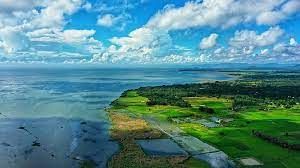
Why in News?
Migratory birds have started their annual journey to Chilika Lake—India’s largest waterbird habitat in Odisha — ahead of winter this year.
About Chilika Lake:
- It is a brackish water lake and a shallow lagoon with estuarine character spread across the districts of Puri, Khurda and Ganjam in the state of Odisha.
- It is connected to the Bay of Bengal by a 32 km long and 1.5 km wide channel that mostly runs parallel to the Bay separated by a narrow spit.
- It is located at the mouth of the Daya River, flowing into the Bay of Bengal, covering an area of over 1,100 km2.
- It can be broadly divided into four ecological sectors based on salinity and depth, namely the southern zone, the central zone, the northern zone and the outer channel.
- It is the largest wintering ground for migratory waterfowl found anywhere on the Indian sub-continent.
- It is one of the hotspot of biodiversity in the country, and some rare, vulnerable and endangered species listed in the IUCN Red List of threatened Animals inhabit the Lake area for atleast part of their life cycle.
- In 1981, Chilika Lake was designated the first Indian wetland of international importance under the Ramsar Convention.
- The Nalaban Island within the lake is notified as a Bird Sanctuary under Wildlife (Protection) Act, 1972.
Source: The Hindu
Pontus Tectonic Plate
Subject: Geography
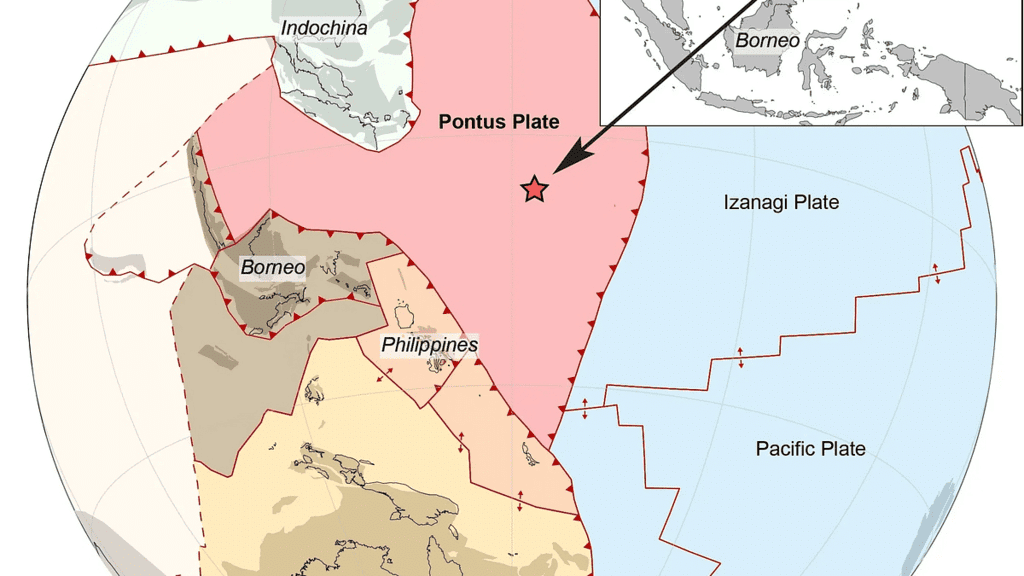
Why in News?
A long-lost tectonic plate dubbed 'Pontus' was recently discovered by chance by scientists studying ancient rocks in Borneo.
About Pontus Tectonic Plate:
- It is a long-lost tectonic plate recently discovered in the west Pacific Ocean.
- It is believed that the massive tectonic plate was once about 15 million square miles in size, which equates to approximately one quarter of the Pacific Ocean.
- It can be traced back as far as 160 million years, and even more recently to around 20 million years back.
- It was slowly subducted and lost over millions of years, pulled down under a neighbouring plate by gravity.
- How the discovery was made?
- The subducting plate is actually denser than the surrounding mantle, so gravity basically pulls the plate down into the mantle.
- A subducted plate leaves behind traces when it 'sinks' into Earth's mantle – namely, fragments of rock hidden in mountain belts.
- During the process of subduction, however, the upper parts of the subducting plate are sometimes scraped off.
- The researchers used geological data to reconstruct the movements of the current plates with computer modelling, which hinted at a wide area potentially vacated by a subducted plate.
- Using magnetic techniques, researchers determined the basalt from Borneo were relics of Pontus that were left behind when this part of the plate subducted, some 85 million years ago.
What is a Tectonic Plate?
- A tectonic plate (also called lithospheric plate) is a massive, irregularly shaped slab of solid rock, generally composed of both continental and oceanic lithosphere.
- Plate size can vary greatly, from a few hundred to thousands of kilometers across; the Pacific and Antarctic Plates are among the largest.
- Plate thickness also varies greatly, ranging from less than 15 km for young oceanic lithosphere to about 200 km or more for ancient continental lithosphere (for example, the interior parts of North and South America).
- Theory of Plate Tectonics:
- Plate tectonics is the theory that Earth's outer shell is divided into large slabs of solid rock, called “plates,” that glide over Earth's mantle, the rocky inner layer above Earth’s core.
- Earth’s solid outer layer, which includes the crust and the uppermost mantle, is called the lithosphere. Below the lithosphere is the asthenosphere — a viscous layer kept malleable by heat deep within the Earth.
- It lubricates the undersides of Earth's tectonic plates, allowing the lithosphere to move around.
Source: Live Science
Deception Island
Subject: Geography
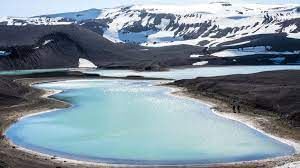
Why in News?
The National Aeronautics and Space Administration (NASA) recently posted a birds-eye-view picture of Deception island on its Instagram handle.
About Deception Island:
- Deception Island is part of a line of islands called the South Shetland Islands, lying northwest of the Antarctic Peninsula.
- It is an active volcano.
- Formation: It was formed by a massive volcanic eruption, which caused the central part of the volcano to collapse and allowed seawater to flood the center, or caldera.
- It has a unique landscape of barren volcanic slopes, steaming beaches, and ash-layered glaciers that form a distinctive horseshoe-shaped opening to the sea through a narrow channel at Neptune’s Bellows.
- The island surrounds Port Foster, one of the safest harbours in the Antarctic.
- It is one of the only places in the world where vessels can sail directly into the centre of a restless volcano.
- It’s one of two active volcanoes around Antarctica, and it has erupted more than twenty times since the 19th century.
- Three volcanic eruptions took place on the island between 1967 – 1970, destroying the Chilean and the British stations.
- At present, Argentina and Spain maintain summer scientific stations there.
- It is now managed as part of the Antarctic treaty, making it a protected area with restricted human visits and impacts.
Source: Times Now
GS-II
Operation Ajay to evacuate Indian nationals from Israel
Subject: International Relations
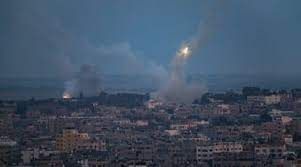
Why in News?
India has initiated Operation Ajay to evacuate its citizens who wish to return from conflict-ridden Israel.
- External Affairs Minister S. Jaishankar announced this operation, emphasizing the safety and well-being of Indian nationals abroad.
Operation Ajay
- Evacuation Plan: Special chartered flights and other arrangements are being organized for the return of Indian citizens from Israel.
- Second Evacuation: This marks the second evacuation operation this year, following Operation Kaveri, which brought back several thousand Indian citizens from strife-torn Sudan in April-May.
Significance: Indian Jewish Community
- The Indian Jewish community, with an ancestry spanning over 2000 years in India, has a unique history.
- India has been a welcoming home to them, where they thrived without encountering anti-Semitism, making it a distinct place on the global map.
- However, the landscape changed with the independence of India in 1947 and the establishment of the state of Israel in 1948.
- This transformation marked the beginning of a new chapter in India-Israel relations, leading to the migration of Indian Jews to their religious homeland.
Diverse Indian Jewish Groups
Indian Jews can be categorized into four main sects, each with its own historical origins and cultural traditions:
- Cochin Jews: Tracing their arrival to India back to 50 CE, they primarily settled in the southern region.
- Bene Israel: The largest group among Indian Jews, they settled in and around Maharashtra and Konkan.
- Baghdadi Jews: This group, part of the most recent wave of Jewish migration, established communities in port cities like Calcutta, Bombay, and Rangoon.
- Bnei Menashe: Settled in the North East, they are another significant segment of Indian Jews.
Complex Reception in Israel
The migration of Indian Jews to Israel was not without challenges. Israeli society struggled to embrace them due to several factors:
- Internal Divisions: The four Indian Jewish groups had substantial differences and disagreements among themselves. These internal divisions, combined with bias from Jews of European origin, complicated the reception of Indian Jews, especially in the initial years of migration.
- Discrimination: The Bene Israel, primarily from Maharashtra, faced significant discrimination upon their arrival in Israel. Reports in the 1950s highlighted instances of racism and unequal treatment, including job and housing discrimination.
- Differing Motivations: Indian Jews’ motivations for migrating varied. While the Cochin Jews were seen as driven by religious reasons, the Bene Israel were often perceived as seeking better economic prospects, leading to different treatment based on perceived motives.
- Economic Disparities: The economic differences among the four groups fueled animosity. Some attributed the Cochin Jews’ messianic aspirations to poverty, while the Baghdadi Jews considered the Bene Israel as lacking proper religious traditions.
Source: The Hindu
Scheduled Areas in India: A Constitutional Framework
Subject: Polity
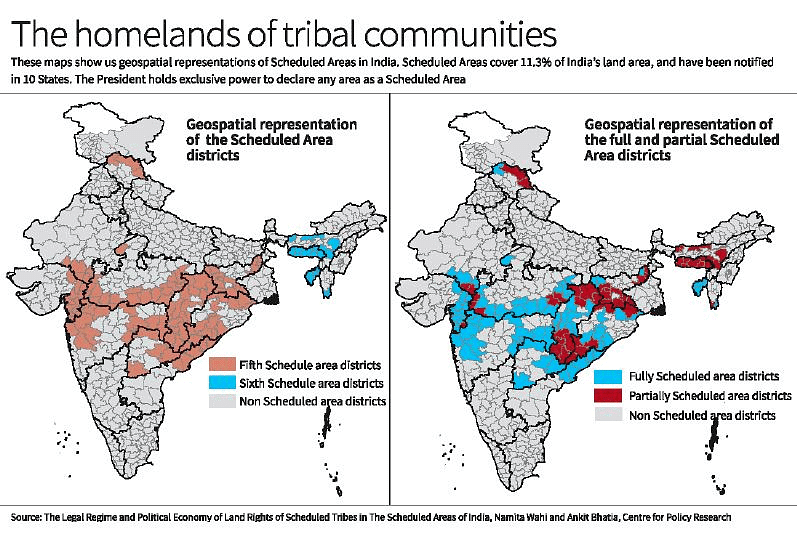
Why in News?
India’s diverse landscape is home to 705 Scheduled Tribe (ST) communities, constituting 8.6% of the nation’s population.
- These communities reside across 26 States and six Union Territories.
- A crucial constitutional provision, Article 244, governs the administration of Scheduled and Tribal Areas, significantly impacting the lives of STs.
Constitutional Framework for STs
- Fifth Schedule (Article 244(1)): This provision applies the Fifth Schedule’s provisions to Scheduled Areas in states other than Assam, Meghalaya, Tripura, and Mizoram.
- Sixth Schedule (Article 244(2)): In the mentioned states, the Sixth Schedule governs the administration of Scheduled and Tribal Areas.
Geographical Scope of Scheduled Areas
- Coverage: Scheduled Areas span 11.3% of India’s land area, designated in 10 States: Andhra Pradesh, Telangana, Odisha, Jharkhand, Chhattisgarh, Madhya Pradesh, Rajasthan, Gujarat, Maharashtra, and Himachal Pradesh. Kerala has proposed additional areas for notification, pending government approval.
- Exclusions: Despite demands from Adivasi organizations, numerous villages in Scheduled Areas and other regions with ST populations have been excluded from Article 244’s purview. Consequently, 59% of India’s STs lack the rights conferred by Scheduled Areas-related laws.
Historical Recommendations
- Bhuria Committee (1995): This committee recommended extending panchayat raj to Scheduled Areas, including the villages, a suggestion yet to be implemented.
- Denotification Debate: Some argue for the denotification of parts of Scheduled Areas where non-tribal individuals have increased, citing the absence of viable ST-majority administrative units.
Governance of Scheduled Areas
- Notification: The President of India designates Scheduled Areas.
- Tribal Advisory Council: States with Scheduled Areas must establish a Tribal Advisory Council with up to 20 ST members to advise the Governor on ST welfare matters.
- Governor’s Role: The Governor reports annually to the President regarding Scheduled Areas’ administration. They can also repeal or amend laws applicable to the Scheduled Area, regulate tribal land transfer, and control money-lending activities.
- Underutilized Provisions: These extensive powers granted to Governors and the President have remained largely inactive, with notable exceptions in Maharashtra from 2014 to 2020.
Defining a Scheduled Area
- Exclusive Presidential Power: The Fifth Schedule exclusively grants the President the authority to declare Scheduled Areas.
- Empirical Basis: A 2006 Supreme Court ruling upheld the executive function of identifying Scheduled Areas and stated that it lacks the expertise to scrutinize this process.
- Criteria: Neither the Constitution nor any law specifies criteria for identifying Scheduled Areas. However, based on the Dhebar Commission Report (1961), key considerations include tribal population predominance, area compactness, administrative viability, and economic backwardness relative to neighboring regions.
Settlement of Ambiguity
- PESA Act (1996): The Provisions of the Panchayats (Extension to Scheduled Areas) Act, 1996, empowered gram sabhas within Scheduled Areas, reinvigorating the intent of the Constitution and the Constituent Assembly. This law enabled direct democracy and recognized the gram sabhas as primary authorities.
- Village Definition: PESA defines a village as a habitation or group of habitations managed by a community according to traditions and customs. This definition extended beyond Scheduled Areas to forest fringes and villages.
- Unresolved Issues: Gram sabhas have yet to demarcate traditional boundaries on revenue lands. FRA 2006 requires the demarcation of “community forest resource” areas within traditional boundaries.
Conclusion
- Understanding and expanding Scheduled Areas in India necessitates the notification of all habitations or groups of habitations with ST majorities outside existing Scheduled Areas.
- Furthermore, geographical boundaries should encompass “community forest resource” areas where applicable and extend to customary boundaries within revenue lands.
- These steps are essential for ensuring equitable governance and preserving the rights and welfare of India’s Scheduled Tribes.
Source: Indian Express
GS-III
White Phosphorous Bombs
Subject: Science and Technology
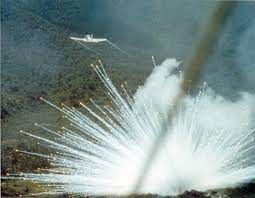
Why in News?
Several photos, videos, and claims on social media allege that Israeli forces are using white phosphorous on the civilian population of Gaza.
About White Phosphorous Bombs:
- White phosphorus is a waxy, yellowish-to-clear chemical with a pungent, garlic-like odour.
- It is a highly combustible chemical that burns quickly and brightly when exposed to air.
- It is used in incendiary weapons by militaries around the world for a variety of purposes, such as illuminating targets at night or to inflicting damage on enemies.
- It burns at a temperature of 800°C and spontaneously ignites at up to 1,300 degrees Celsius when it is exposed to oxygen, and producing white, dense smoke, which is used by armies to create smokescreens in sensitive zones.
- White phosphorus can cause fast-moving and widespread fires on the ground.
- Once ignited, the substance is very difficult to put out, as it clings to many surfaces, including skin and clothing.
- Since it is a wax-like substance, it is very hard to remove and often lights up again when the bandages are removed.
- White phosphorus munitions are not banned under international law, but because of their incendiary effects, their use is supposed to be tightly regulated.
- Examples of White Phosphorous usage in wars:
- The British army used it in both World Wars.
- US forces, after invading Iraq, used the chemical weapon against insurgents in the city of Fallujah.
- Israel admitted that it used phosphorus shells during the battle against Hezbollah during the 2006 Lebanon War.
What are incendiary weapons?
- They are weapons or munitions designed to set fire to objects or cause burns or respiratory injuries to people through the action of flame, heat, or a combination thereof, resulting from a chemical reaction of a flammable substance such as napalm or white phosphorus.
- In 1972, the United Nations General Assembly passed a resolution calling incendiary weapons a "category of arms viewed with horror."
- The definition in Article 1 of Protocol III of the Convention on Certain Conventional Weapons excludes multipurpose munitions, particularly those containing white phosphorus.
- Because white phosphorus has legal uses, shells filled with it are not directly prohibited by international humanitarian law.
Source: The Hindu
Goa’s Cashew Industry receives GI Tag
Subject: Economics

Why in News?
Goa’s Cashew IndustryThe recent awarding of a Geographical Indication (GI) tag to Goa’s cashew industry has ignited hope and enthusiasm among cashew manufacturers and processors in the state.
- Introduction of Cashew in Goa: Cashew was introduced to Goa in the 16th century by Portuguese colonizers. Initially, it was primarily cultivated for afforestation and soil conservation purposes.
- Discovery of Edible Value: The true economic value of cashew nuts was discovered during Goa’s freedom movement in the mid-18th century. Goan prisoners exiled to Portuguese territory in Africa (Mozambique) recognized the edible potential of cashew nuts.
- Growth of Cashew Industry: Cashew production evolved from a cottage industry to a large-scale enterprise, driven by demand, particularly in the USA. The first cashew factory in Goa began operations in 1926, and the first consignment of cashew kernels was exported in 1930.
- Foreign Trade Contribution: By 1961, the cashew processing industry accounted for about 60% of industrial production in Goa. Cashew nuts, both locally grown and imported, were processed and exported to countries like the United States of America, Japan, Saudi Arabia, and West Germany.
- A GI is a sign used on products that have a specific geographical origin and possess qualities or a reputation that are due to that origin.
- Nodal Agency: Department for Promotion of Industry and Internal Trade (DPIIT), Ministry of Commerce and Industry
- India, as a member of the World Trade Organization (WTO), enacted the Geographical Indications of Goods (Registration and Protection) Act, 1999 w.e.f. September 2003.
- GIs have been defined under Article 22 (1) of the WTO Agreement on Trade-Related Aspects of Intellectual Property Rights (TRIPS) Agreement.
- The tag stands valid for 10 years.
Source: The Hindu
|
38 videos|5283 docs|1116 tests
|
















